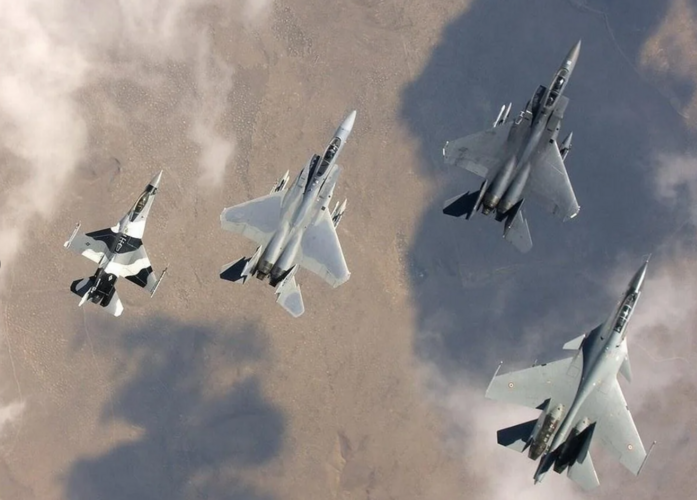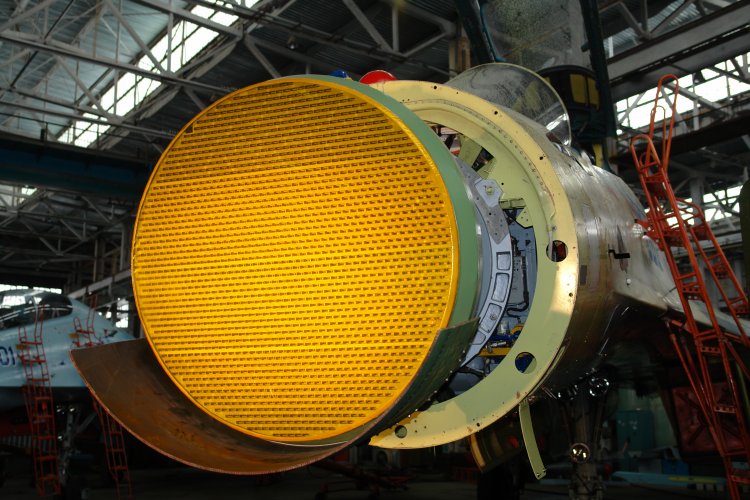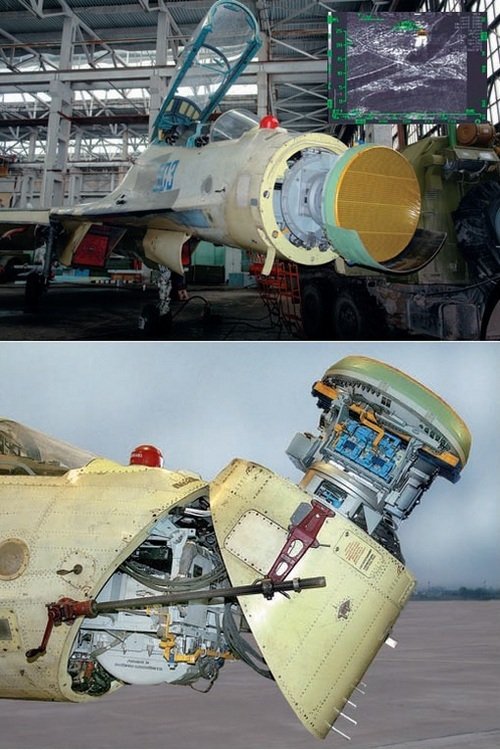Ainen
I really should change my personal text
- Joined
- 25 August 2011
- Messages
- 1,270
- Reaction score
- 1,705
101KS-O are fully functional IRSTs.How's that?
101KS-O are fully functional IRSTs.How's that?
IIRC, 101KS-O are electro optical rather than IIR. Basically similar to TCS rather than AAS-42101KS-O are fully functional IRSTs.
Based on Tass news and overscan's source what kind of stuff does the Su-35SE have? N011M bars? irbis?
One thing that always bugging me is how come Irbis average power is only 5kW which work out to max duty cycle of 25%. I wonder why it doesn’t have the 50% duty cycle mode like AWG-9 for extreme range. AWG-9 average power is something like 10kW.There is no "Su-35SE" or "Su-35K" All there is only "Su-35".
It will come with Irbis by default. Export version of course but still Irbis with her 20 KW glory and 90 cm antenna. If you want Bars then buy Su-30SM, she has Bars.
One thing that always bugging me is how come Irbis average power is only 5kW which work out to max duty cycle of 25%. I wonder why it doesn’t have the 50% duty cycle mode like AWG-9 for extreme range. AWG-9 average power is something like 10kW.
I understand that you can't measure range with pulse delay in VS mode, however, it is still plausible to measure range by motion analysis or altitude different ranging. I think Irbis with 50% duty cycle could have even more insane range than it does now.Now 50% duty cycle means the radar PRF or pulsewidth will be so large that even when you start "listening" to return pulse after you transmitted your waveform, you can actually still receive returns from target. But you cant make use of this as that pulse may arrive at the time when you start transmitting, the duplexer engages and thus whatever "excess" you have is lost.
The other drawback is no range measurement, despite having longest range, this 50% mode have name "VS" or Velocity Search only, means you cannot measure range, you have to rely on FM Ranging. Also No tailchase/not all aspect. Only good against head on closing target.
Ah yes, I miss remember. It was the APG-71 that has 7kW averageAlso AWG-9 is 5 KW peak like Irbis. 10 KW being the peak.
Those are laser "guns" first, jamming modern(imaging) IR missiles.IIRC, 101KS-O are electro optical rather than IIR. Basically similar to TCS rather than AAS-42
it is still plausible to measure range by motion analysis or altitude different ranging
I think Irbis with 50% duty cycle could have even more insane range than it does now.
I mean 101KS-O has laser turret but the sensor that used to steer the laser turret is CCD rather than IIRThose are laser "guns" first, jamming modern(imaging) IR missiles.
Its mirror is consequently for same bands as WVR missile seekers.
But it's also a sensor - because, unlike optical jammer(that can be aimed roughly), coherent jammmer needs to lase exactly the seeker of the target. It is its own source of (laser, but almost certainly not only) firing solution.
Or did you mean KS-V/OLS-50M?(which btw may also have turret function, but this is my speculation)
agree, but why not having something working at Low-medium-high depend on situation?Not as accurate as good ol Pulse delay ranging. Thus why you still have radar works in Low-Medium PRF.
yes, but I would think that 50% duty cycle AWG-9 has longer range than 20% duty cycle AWG-9 , so Irbis is the sameYou still wont solve eclipsing loss tho, and that will cap your range.
agree, but why not having something working at Low-medium-high depend on situation?
We don't need to use 50% duty cycle all the time.
yes, but I would think that 50% duty cycle AWG-9 has longer range than 20% duty cycle AWG-9 , so Irbis is the same
That's long since been debunked, as the aircraft in the picture wasn't even an F-22. The only footage from The OLS-35 that I've been able to find is this clip via Twitter, below, that shows an MQ-9 Reaper at point-blank range, which isn't exactly very helpful for our purposes.You sure Joint Soviet Fighter? I thought I remember an su-35 getting ir imagery of an f-22 from its EO sight a few years back.
An MQ-9 Reaper as seen through the OLS-35 IRST of a russian SU-35S over syria pic.twitter.com/RkFVhgfSAr
— A³ (@cyphe0r) June 27, 2024
It's already done. Like current fighter radars have all Low-Medium-High PRF modes. e.g Low PRF for no clutter situation or ground mapping, medium PRF is for all-aspect detection and interleaved with High PRF. It's just that duty cycle are typically 25-30%.
Even the current block 3, F-35 has 40kW cooling, F-15E currently has 35kW cooling that can be expanded to 52kWMaybe but what if your cooling or even weight constraint cannot allow more ? radar cooling capacity are dictated by average power. the more power, means more cooling. More cooling means heavier cooler or heavier cooling fins.

Even the current block 3, F-35 has 40kW cooling, F-15E currently has 35kW cooling that can be expanded to 52kW
yeah, such a shame that they don't use 50% anymore it seem
Isn’t APG-79 has like 12 kw of cooling? Giving irbis 10 kw cooling doesn’t seem so crazyYou dont use them all for Radar tbh.
With higher duty cycle, you can transmit pulse with lower peak power and still get the same detection range. Radar with higher duty cycle can be harder to detect, ancient radar actually has very low duty cycle and high peak powerIt really isn't. 50% duty cycle sacrifices range measurement accuracy for a minor range increase. Modern radars don't need it. In fact modern radars use the least power possible while achieving needed range, not blasting out high power for the sake of it.
Alternative to BARS radar on Su 30MKI.
— Defence Matrix (@Defencematrix1) February 11, 2025
Please note, here the antenna can move left to right and up as well as down, whereas the original BARS antenna is fixed.
A system by Data Patterns. pic.twitter.com/TG1ypPIipE
Indian program always promise so many thing but take forever to completeThere is another radar for a possible new MKI radar from India. 350km vs 5sqm, 250km vs 2sqm and 200km vs 1 sqm.
View: https://x.com/Defencematrix1/status/1889269422503669903Alternative to BARS radar on Su 30MKI.
— Defence Matrix (@Defencematrix1) February 11, 2025
Please note, here the antenna can move left to right and up as well as down, whereas the original BARS antenna is fixed.
A system by Data Patterns. pic.twitter.com/TG1ypPIipE
Nothing special here, just an ordinary 25kW GaN AESA. Easy-PeasyIndian program always promise so many thing but take forever to complete
Acc. to @stealthflanker 's calculations, that other radar that is offered for the "super flanker mod." seemed quite capable already so do I smell a competition on the horizon?There is another radar for a possible new MKI radar from India. 350km vs 5sqm, 250km vs 2sqm and 200km vs 1 sqm.
View: https://x.com/Defencematrix1/status/1889269422503669903Alternative to BARS radar on Su 30MKI.
— Defence Matrix (@Defencematrix1) February 11, 2025
Please note, here the antenna can move left to right and up as well as down, whereas the original BARS antenna is fixed.
A system by Data Patterns. pic.twitter.com/TG1ypPIipE
Range wise it will be improvement over all Indian fighters in service, competitive even against Russian Irbis or US APG-82 for F-15EX. in high PRF (250 KHz) It is able to pick a 3 sqm target in 296 km range. Remains to be seen tho how India will use that range advantage. pic.twitter.com/Fi15qG2TIY
— Dhimas Afihandarin (@Flankerchan) October 8, 2024
The oldest Sukhoi flying laboratory of Su-35 (T10M-10, Su-30I-3) still in business. The fighter has air brake & canard unlike serial Su-35S. pic.twitter.com/fa9hGjAPWm
— KURYER🤔 (@RSS_40) November 1, 2016
Indian program always promise so many thing but take forever to complete
— O R C A Military 🇩🇿 (@kmldial70) March 13, 2025
Its the "Swift Rod" ILS antenna, whose correct Russian designation escapes me at the moment.
No Odd Rods since Parol replaced Khrom-Nikyel in the late 70s.So no "Odd Rods"?
One thing that always bugging me is how come Irbis average power is only 5kW which work out to max duty cycle of 25%. I wonder why it doesn’t have the 50% duty cycle mode like AWG-9 for extreme range. AWG-9 average power is something like 10kW.
Well eclipsing phenomenon. As the radar only have 1 antenna, you will need means to protect the receiver from power spillage during transmission, Thus duplexer exist.
Now 50% duty cycle means the radar PRF or pulsewidth will be so large that even when you start "listening" to return pulse after you transmitted your waveform, you can actually still receive returns from target. But you cant make use of this as that pulse may arrive at the time when you start transmitting, the duplexer engages and thus whatever "excess" you have is lost.
The other drawback is no range measurement, despite having longest range, this 50% mode have name "VS" or Velocity Search only, means you cannot measure range, you have to rely on FM Ranging. Also No tailchase/not all aspect. Only good against head on closing target.
Also AWG-9 is 5 KW peak like Irbis. 10 KW being the peak.
I understand that you can't measure range with pulse delay in VS mode, however, it is still plausible to measure range by motion analysis or altitude different ranging. I think Irbis with 50% duty cycle could have even more insane range than it does now.
Ah yes, I miss remember. It was the APG-71 that has 7kW average
It's already done. Like current fighter radars have all Low-Medium-High PRF modes. e.g Low PRF for no clutter situation or ground mapping, medium PRF is for all-aspect detection and interleaved with High PRF. It's just that duty cycle are typically 25-30%.
Maybe but what if your cooling or even weight constraint cannot allow more ? radar cooling capacity are dictated by average power. the more power, means more cooling. More cooling means heavier cooler or heavier cooling fins.



Good job for the pilot Deino, getting the Su-34 back without any further issues.
